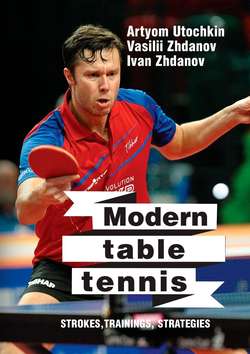Читать книгу Modern table tennis: strokes, trainings, strategies - Artyom Utochkin - Страница 5
Chapter 1. Modern table tennis
The role of the backhand top-spin in modern table tennis. History of the paradigm shift
ОглавлениеBall possession with the left topspin performed by today’s table tennis stars is fascinating. In modern table tennis, we see that the backhand top-spin is executed at high speed. Masters of a small ball skillfully use it in close proximity to the table and in the middle zone. Nevertheless, the role of the backhand top-spin and its purpose in modern table tennis is not the same as it was 15—20 years ago.
In order to assess its role, we need to look into history and understand how the backhand top-spin developed, what has changed and how it came to today’s version. The backhand topspin (loop) began to develop later than the forehand loop.
If the Japanese athletes began to apply the forehand topspin at the very end of the 50’s, then the backhand topspin appeared in the European school in the second half of the 60’s.
The greatest wizards of the backhand topspin were Hungarian and Yugoslav athletes. Such masters as Gábor Gergely, Istvan Joner, Dragutin Shurbek and others.
In the 70—80’s, the backhand topspin was used on an equal ground with the forehand topspin and was executed from the same distance. At that time, players always had some dominant side: someone had a more powerful forehand topspin, and someone performed more powerful backhand topspin. A vivid example of an athlete with a dominant and more powerful left side is our great Soviet athlete Andrei Mazunov.
The paradigm of using the left stroke (not speaking about top-spin, but the game itself) gradually began to change in the second half of the 1980’s. The pioneers were leading Swedish athletes (Jan-Ove Waldner, Jörgen Persson, Mikael Appelgren).
In the late 70’s and early 80’s, as you remember from the first part of the story about the forehand loop (topspin), Chinese athletes performed a very active game near the table using attacking pimples.
European athletes who used top-spin from the middle and far zones began to lose to the Chinese, not having any chance against them in speed.
A new generation of Swedish tennis players used the following antidote: they approached the table and began to perform top-spin at the highest point of the ball rebound. It was difficult for the Chinese tennis players to cope with such an attack and gradually they also switched to another game model using a topspin with a smooth rubber.
The fact that Swedish athletes began to play closer to the table also influenced the tactics of the game on the left side. They began to play much closer to the table on the left side.
If the forehand topspin, having undergone a number of changes in technique, was used by tennis players constantly, at every opportunity, then the backhand loop developed less rapidly.
In the mid 80’s a new generation of European athletes led by Swedish masters played performed the backhand loop in only half of the opportunities. Very often, an active counter-play was performed on the left side of the table.
Backhand loop technique, due to which one could perform the backhand top-spin close to the table, was not yet determined by that time. Anyway, the full execution of the backhand topspin forced the athlete to move slightly to the middle zone. In such a situation, hand counterdrive near the table often was much more effective, supporting the attack speed and allowed to stay closer to the table when playing on the left side and not moving to the middle zone.
The vivid examples of such game model were Jan-Ove Waldner and Ma Wenge. Both these athletes were in the top five at that time, and most often in the top three of the world’s best athletes.
If we look at today’s table tennis, we can see the following picture: the leading athletes perform the backhand topspin near the table, with a rather short hand movement, without trying to win the point by this move.
The idea of today’s backhand loop is not to lose the game on the left diagonal, and to create an opportunity to perform the more powerful forehand loop.
If we look back once again, we will notice that players like Jan-Ove Waldner and Ma Wenge used the prototype of today’s game model. The idea was the same – they used the left-side game in order to keep the opponent on the tenterhooks at high speed and prepare a platform for a more powerful forehand loop. The only difference from the modern game model is that the hard left-side counter-play near the table was replaced by the backhand topspin, which is also performed near the table but is more variable and difficult for the opponent and more reliable for the one who performs it.
The first sportsman who suggested such game model: the backhand topspin in the near zone + the powerful forehand top-spin – was the Chinese athlete Kohn Linghu.
He is rightfully considered the “father” of today’s table tennis developing trend.
The way he came up with this idea remains a mystery. It is possible that it wasn’t his idea, but, for example, his coach, but that is just the point that Kohn Linghu was the first to perform the model of table tennis that we see now in the game of leading Asian and European masters.
By the way, Kohn Linghu became the world champion in 1995 and the 2000 Olympic champion. During these 5 years he took first place in the world ranking very often. As you can see, it was not that simple.
To date, the backhand topspin technique close to the table, performed by such masters as Ma Long, Czhan Chzhike, Fan Zhendong has reached great heights. They began to play even sharper, more diverse, but still the paradigm of the game offered by Kohn Linghu remains unchanged.
